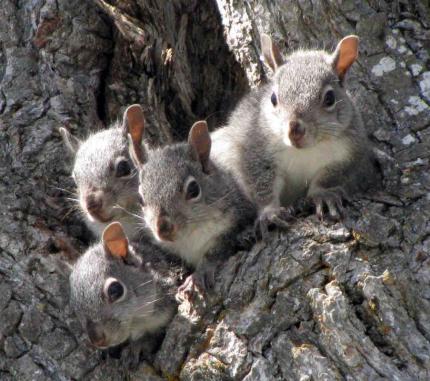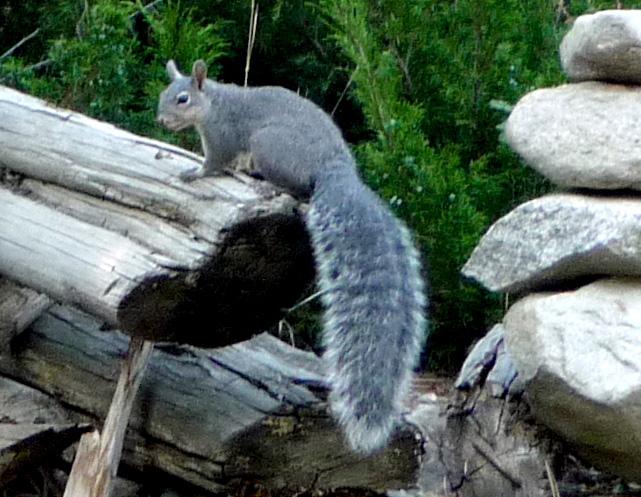Moderate-
High
The three remaining populations of the western gray squirrel in Washington are isolated and face a number of threats, including habitat loss and degradation, wildfires, highway mortality, and disease. The squirrel occupies oak woodlands and conifer forests in Klickitat and Yakima Counties, low to mid-elevation conifer forests in Okanogan and Chelan Counties, and oak woodlands and conifer forests in Pierce and Thurston Counties. The North Cascades population is the only one living outside the range of Oregon white oak in Washington.
Western gray squirrels are a protected species in Washington and cannot be hunted, trapped, or killed (WAC 220-200-100).
The Washington Department of Fish and Wildlife (WDFW) maintains records on the distribution of western gray squirrels in Washington. The public’s assistance in reporting sightings of this species is appreciated.
Description and Range
Physical description
The western gray squirrel is the largest tree squirrel native to the Pacific Northwest. They are steel gray on the back, with contrasting white on the belly and throat, resulting in the name, "silver gray squirrel" in some parts of their range. They are distinguished by their very long and bushy tails that are primarily gray with white-frosted outer edges. They also have prominent ears, which can be reddish-brown on the back in winter. This occasional small patch of brown is only visible upon close inspection and is the only part of the squirrel that may have any brown.
Western gray squirrels are often confused with introduced eastern gray squirrels that are increasingly common in Washington’ urban areas. The western gray squirrel's large size, bushy tail, and gray fur lacking any brown on the body or tail are keys to distinguishing it from other tree squirrels in Washington.
Ecology and life history
Western gray squirrels are most frequently associated with pine trees, which provide nesting cover and seeds for food, and oak trees, which provide natal den sites and acorns for food. In Washington, they also use stands of Douglas fir trees when a component of oak or pine is present. The squirrels require mature stands of trees with sufficient canopy cover to provide secure nest sites and allow for traveling about in trees. They also need a diverse selection of vegetation to provide a multitude of food resources.

Tree squirrels feed mostly on plant material, including seeds, nuts, acorns, tree buds, berries, leaves, and twigs. However, squirrels are opportunists and also eat fungi, insects, and occasionally birds’ eggs and nestlings.
Squirrels store food and recover it as needed. Hollow trees, stumps, and abandoned animal burrows are used as storage sites. Flower pots, exhaust pipes, and abandoned cars are also used.
Western gray squirrels mate from early winter to late spring, with one litter of two to four young appearing from March to June. After about 30 days of age, the young are fully furred and make short trips out of the nest. At about 60 days of age, they eat solid foods and venture to the ground.
At about three months of age, juvenile squirrels are on their own, sometimes remaining close to the nest until their parents’ next breeding period.

All tree squirrels create nursery nests in hollow trees, abandoned woodpecker cavities, and similar hollows. Where these are unavailable, they will build spherical or cup-shaped nests in trees, attics, and nest boxes. Western gray squirrel nests are large and often clustered in dry oak / conifer forests.
Occupied nests may have fresh leaves, green conifer boughs, or lichen on top. Nesting frequently occurs in either large conifers (especially ponderosa pine and Douglas-fir) or oaks averaging greater than 16 inches in diameter. Most nest trees are located inside or on the edge of a forest stand and have crowns connecting with surrounding trees. Mistletoe infections are another common characteristic of nest trees.
In trees, squirrels are relatively safe, except for the occasional owl or goshawk. On the ground, large hawks and owls, domestic cats and dogs, coyotes, and bobcats catch squirrels.
Vehicles, disease, and starvation also kill squirrels. Population density varies with food supply and occurrence of disease. Most squirrels die during their first year. If they can survive the first year, they typically live three to five years.
Geographic range
The western gray squirrel was once common at low to mid-elevations in dry forests where oak, pine, and Douglas fir mix. It could be found in the south Puget Trough and Columbia River Gorge and on the east slope of the Cascades north to Okanogan County.
It's range is now limited to three isolated populations: the oak woodlands and conifer forests of Klickitat and southern Yakima counties; low to mid-elevation conifer forests in Okanogan and Chelan counties; and the oak woodlands and conifer forests on Joint Base Lewis-McChord in Pierce and Thurston counties. The North Cascades population is the only one occurring outside of the range of Oregon white oak in Washington.
For maps of worldwide distribution and conservation status of this species, check out NatureServe Explorer and the International Union for the Conservation of Nature Red List.
Climate vulnerability
Sensitivity to climate change
Moderate-
High
Western gray squirrels are susceptible to altered fire regimes that degrade forest quality for extended periods of time. For example, the major wildfires that occurred in Okanogan and Chelan counties in 2014 and 2015 destroyed large amounts of western gray squirrel habitat and also caused direct mortality to the squirrels. Smaller, but still important fires have also burned habitat for the species in Klickitat and Yakima counties in recent years. Additionally, western gray squirrels are sensitive to disease outbreaks (e.g., mange, Western equine encephalitis virus), which could become more frequent with warmer temperatures. Despite these concerns, one recent study has projected that some forest types used by the squirrels will expand under warmer, drier conditions, which may benefit the species in Washington.
Exposure to climate change
Moderate
- Altered fire regimes
- Increased disease outbreaks
- Increased temperatures
- Changes in precipitation
Regulations
Rules and seasons
Western gray squirrels are a protected species in Washington and cannot be hunted, trapped, or killed (WAC 220-200-100).
Conservation
The western gray squirrel was added to Washington’s list of state threatened species in 1993 when surveys indicated a decline in its geographical distribution. The species was uplisted to state endangered in 2023.
Conservation Threats and Actions Needed
- Fish and wildlife habitat loss or degradation
- Threat: Habitat loss and degradation from human development, catastrophic wild fires, logging, fire suppression, and invasion by weeds. The amount of suitable habitat available to western gray squirrels has declined substantially as a result of urban/suburban development, fragmentation of oak woodlands, conversion of oak woodlands to softwood stands through fire suppression, and changes to forest composition and structure as a result of commercial forestry practices.
- Action Needed: Work with landowners to protect habitat features favored by western gray squirrels, during timber harvest, protect habitat by reducing risk of catastrophic wildfires, and undertake measures to enhance habitat.
- Threat: Mortality by vehicles on roads.
- Action Needed: Use signing, reduced speed limits, controlled access, and possibly squirrel bridges to reduce highway mortality.
- Threat: Loss of genetic diversity and inbreeding resulting from the small sizes and isolation of populations.
- Action Needed: Conduct translocations and enhance habitat to expand the genetic diversity and connectivity of small populations.
- Invasive and other problematic species
- Threat: Invasion of oak woodlands by non-native plants like Scot’s broom.
- Action Needed: Manage oak woodlands to control invasion by non-native plants.
- Threat: Disease (example: mange, tularemia).
- Action Needed: Investigate the feasibility and effectiveness of treating western gray squirrels for mange.
- Threat: Possible competition with non-native squirrels, such as the eastern gray squirrel, and wild turkeys.
- Action Needed: Explore need and feasibility to control non-native squirrels. In important western gray squirrel areas, expand turkey harvest, where appropriate, to minimize potential impacts.
See the Climate vulnerability section above for information about the threats posed to western gray squirrel by climate change.
Living with wildlife
When the public is polled regarding suburban and urban wildlife, tree squirrels generally rank first as problem makers. Residents complain about them nesting in homes and exploiting bird feeders. Interestingly, squirrels almost always rank first among preferred urban/suburban wildlife species. Learn how to live with tree squirrels and prevent conflicts.
Resources
References
Gregory, S. C., W. M. Vander Haegen, W. Y. Chang, and S. D. West. 2010. Nest site selection by western gray squirrels at their northern range terminus. Journal of Wildlife Management 74:18-25.
Linders, M. J. and D. W. Stinson. 2007. Washington state recovery plan for the western gray squirrel. Washington Department of Fish and Wildlife, Olympia, Washington.
Vander Haegen, W. M., G. R. Roth, and M. J. Linders. 2013. Survival and causes of mortality in a northern population of western gray squirrel. Journal of Wildlife Management 77:1249–1257.
WDFW publications
PHS Program
Recovery plans
- Washington State Recovery Plan for the Western Gray Squirrel (2007)
- Recovery actions
- Western gray squirrel ecology and augmentation of the population in the South Puget Trough: 2010 Annual Progress Report
- Western gray squirrel ecology and augmentation of the population in the South Puget Trough: Progress Report (2009)
- Implementation Plan for Augmentation of the Western Gray Squirrel Population, Fort Lewis, Washington (2007)
Status reports
- Washington State Periodic Status Review for the Western Gray Squirrel (2023)
- Washington State Periodic Status Review for the Western Gray Squirrel (2016)
- Status of the Western Gray Squirrel (Sciurus Griseus) in Washington (1993)
Research
- Assessment of habitat change for western gray squirrels in the eastside Cascades of Washington, 1993-2017 (2022)
- Occupancy surveys for western gray squirrels in Washington (2021)
